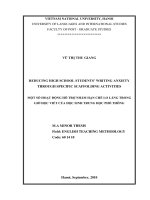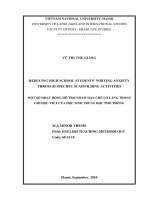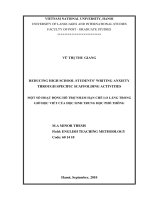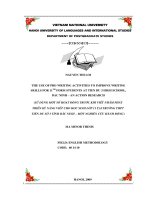(Luận văn thạc sĩ) reducing high school students writing anxiety through specific scaffolding activities
Bạn đang xem bản rút gọn của tài liệu. Xem và tải ngay bản đầy đủ của tài liệu tại đây (174.14 KB, 4 trang )
VIETNAM NATIONAL UNIVERSITY, HANOI
UNIVERSITY OF LANGUAGES AND INTERNATIONAL STUDIES
FACULTY OF POST - GRADUATE STUDIES
*************************
VŨ THỊ THU GIANG
REDUCING HIGH SCHOOL STUDENTS’ WRITING ANXIETY
THROUGH SPECIFIC SCAFFOLDING ACTIVITIES
MỘT SỐ HOẠT ĐỘNG HỖ TRỢ NHẰM HẠN CHẾ LO LẮNG TRONG
GIỜ HỌC VIẾT CỦA HỌC SINH TRUNG HỌC PHỔ THÔNG
M.A MINOR THESIS
Field: ENGLISH TEACHING METHODLOGY
Code: 60 14 10
Hanoi, September, 2010
VIETNAM NATIONAL UNIVERSITY, HANOI
UNIVERSITY OF LANGUAGES AND INTERNATIONAL STUDIES
FACULTY OF POST - GRADUATE STUDIES
*************************
VŨ THỊ THU GIANG
REDUCING HIGH SCHOOL STUDENTS’ WRITING ANXIETY
THROUGH SPECIFIC SCAFFOLDING ACTIVITIES
MỘT SỐ HOẠT ĐỘNG HỖ TRỢ NHẰM HẠN CHẾ LO LẮNG TRONG
GIỜ HỌC VIẾT CỦA HỌC SINH TRUNG HỌC PHỔ THÔNG
M.A MINOR THESIS
Field: ENGLISH TEACHING METHODLOGY
Code: 601410
Supervisor: ĐỖ BÁ QUÝ, MEd.
Hanoi, September, 2010
iv
TABLE OF CONTENTS
CANDIDATE’S STATEMENT ..................................................................................... i
ACKNOWLEDGEMENTS ......................................................................................... ii
ABSTRACT .................................................................................................................. iii
TABLE OF CONTENTS ............................................................................................. iv
LIST OF TABLES ....................................................................................................... vi
LIST OF ABBREVIATIONS ..................................................................................... vii
PART A. INTRODUCTION ........................................................................................ 1
1. Rationale .................................................................................................................... 1
2. Aims of the study ........................................................................................................ 2
3. Research questions ...................................................................................................... 3
4. Scope of the study ....................................................................................................... 3
5 Method of the study...................................................................................................... 3
6. Design of the study ...................................................................................................... 3
PART B. DEVELOPMENT ......................................................................................... 5
CHAPTER 1. LITERATURE REVIEW ..................................................................... 5
1.1. Writing skill in second language (L2) teaching and learning ..................................... 5
1.1.1. Product writing ...................................................................................................... 5
1.1.2. Process approach to teaching writing ..................................................................... 7
1.1.3. Process vs. Product ................................................................................................ 9
1.2. Anxiety in L2 learning ............................................................................................10
1.2.1 Writing anxiety in L2 learning ...............................................................................10
1.2.2. Sources of writing anxiety ....................................................................................11
1.3. Scaffolding second language teaching and learning .................................................11
1.3.1. The Zone of Proximal Development (ZPD)...........................................................12
1.3.2. The definition of Scaffolding ...............................................................................13
1.3.3 Features of Scaffolding .........................................................................................15
1.3.3.1. Extending understanding ....................................................................................15
1.3.3.2. Temporary support .............................................................................................16
1.3.3.3. Principles of scaffolding ....................................................................................17
v
CHAPTER 2. METHODOLOGY ..............................................................................19
2.1. The context of study ................................................................................................19
2.1.1. The school ............................................................................................................19
2.1.2. Description of writing section in English 10 textbook ...........................................19
2.2. Research questions ..................................................................................................21
2.3. Research methods ....................................................................................................21
2.3.1. The teachers .........................................................................................................22
2.3.2. The students .........................................................................................................22
2.3.3. Instruments and procedure ....................................................................................23
2.4. Data analysis process ...............................................................................................24
2.5. Summary ................................................................................................................24
CHAPTER 3. DATA ANALYSIS AND DICUSSIONS ..............................................25
3.1 Teachers’ questionnaire……………………………………………………………… 25
3.1.1 Teachers’ attitudes towards writing skill……………………………………………25
3.1.2 Teachers’ perceptions on scaffolding strategies in teaching writing………………..25
3.1.3 Teachers’ opinion on proposed scaffolding activities in writing……………………26
3.1.4. Teachers’ judgments on difficulties faced by students in learning writing skill …..28
3.1.5 Teachers’ real practice in teaching writing skill…………………………………….28
3.2. Students’ questionnaire……………………………………………………………….30
3.2.1. Students’ attitudes towards writing skill …………………………………………..30
3.2.2. Students’ difficulties in learning writing skill…………………………………...…31
3.2.3. Students’ preference for some scaffolding activities……………………………….32
3.3. Findings from interview ................................................................................... …....34
3.4. Findings from classroom observation..................................................................... ..35
3.5. Summary……………………………………………………………………………...36
PART C. CONCLUSION............................................................................................38
1. Conclusions ................................................................................................................38
2. Pedagogical implications ...........................................................................................39
3. Limitations ................................................................................................................40
4. Suggestions for further study ......................................................................................40
References .....................................................................................................................42
Appendices









